The U.S. dollar continued outperforming all the other G10 currencies, perhaps as investors appear to be liquidating positions everywhere in favor of holding cash. Equities resumed their tumble and kept trading south, even after major central banks proceeded with more stimulus measures, in their coordinated attempt to rescue the global economy from the effects of the coronavirus. Back to the FX world, Cable slid to territories last seen in 1985, with investors perhaps selling pounds due to the additional risk of Brexit.
DOLLAR KEEPS GAINING AS INVESTORS LIQUIDATE EVERYTHING
The dollar continued rallying against all the other G10 currencies on Wednesday and during the Asian morning Thursday. It gained the most versus NOK, AUD, NZD and GBP in that order, while it eked out the least gains versus CHF, EUR and JPY.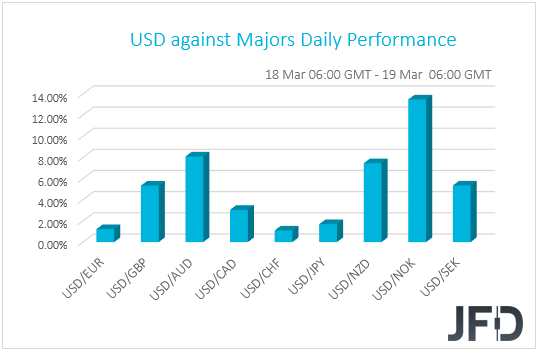
The relative strength of the yen the franc and the euro, combined with the weakening of the risk-linked Aussie and Kiwi, suggests that the financial world has turned back to risk off trading. That said, the fact that the dollar outperformed even the traditional safe-havens JPY and CHF, as well as the further tumble in gold, point to what we have said yesterday. Namely, investors appear to be liquating positions everywhere in favor of holding cash, and especially dollars, the world’s reserve currency. Even bond yields were up, as investors abandoned bonds as well. In a leveraged world, this may have been happening in order to cover losses and margin calls in risk assets, like equities.
Shifting our attention to the equity world, we see a sea of red. Major EU and US indices turned down again, closing well in the red, with the negative investor morale rolling into the Asian trading today. Both Japan’s Nikkei 225 and China’s Shanghai Composite slid 1.04% and 0.98% respectively. Yesterday morning, we noted that we don’t expect Tuesday’s bounce to continue, adding that since February 20th, we rarely saw two consecutive days of gains in the equity markets. All this comes to confirm that observation.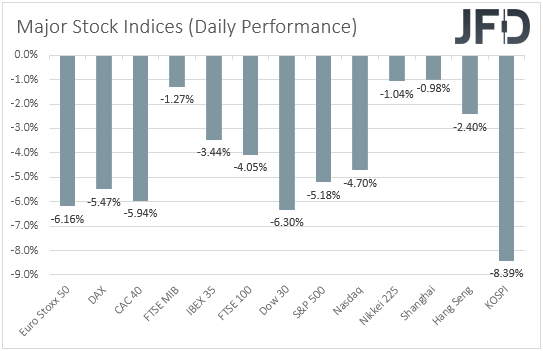
Overnight, major central banks proceeded with more stimulus measures, but, apparently, the efforts were once again unsuccessful in calming panicked investors. In out-of-scheduled meetings, the ECB pledged to buy EUR 750bn in bonds through the whole year, while the Fed promised to make loans to banks that offer asset purchased from money market mutual funds as collateral. What’s more, the RBA cut interest rates to a new all-time low of 0.25%, and announced that it will start QE purchases for the first time in its history.
The market reaction to the extra stimulus efforts enhances our long-standing view that the worst is not behind us yet. We repeat that with monetary and fiscal easing, consumers have to get out of their homes and start spending, for the engines of the global economy to restart. With the daily infected cases and deaths hitting new records day by day, we see that as a very hard task. Just for the record, only yesterday we had 20584 new infections and 973 new deaths. As for the economic outlook, remember that when everyone was pointing to a temporary impact only in Q1, our call was that the economic wounds could well drag into Q2. It appears that this will be the case, and if any vaccine does not start being distributed to the world soon, the globe could suffer well beyond the first half of the year.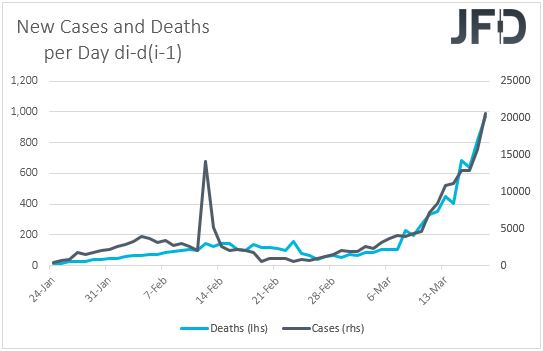
Back to the currencies, the pound was among the main losers, with Cable tumbling well below its 2019 low of 1.1958 and testing territories last seen in 1985. Apart from the broader dollar strength, investors and traders may have been abandoning the pound as the last thing they would like to do at the moment, is holding assets with extra risk, and the extra risk related to the pound is Brexit and the transition-period negotiations. It seems that pound traders were quick to erase from their memory the 50bps cut by the BoE and the large fiscal stimulus package announced by Chancellor Rishi Sunak.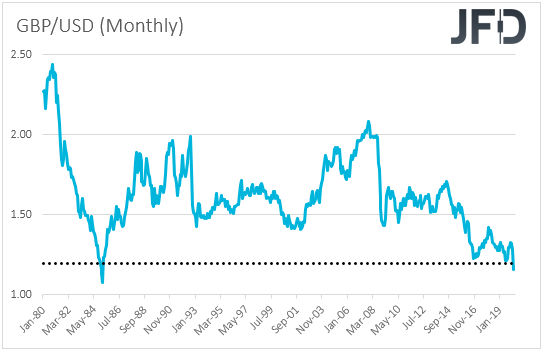
Overall, we maintain the view that equities have not hit a bottom yet, and that risk-linked currencies will continue tumbling. Given the aforementioned argument, the pound may also be poised for further declines. The safe havens yen, franc and the euro, may continue standing tall, but we would avoid exploiting gains in these currencies against the dollar. Dollar is the king nowadays. Thus, with all that in mind, currency pairs that may be poised to continue sliding at a decent pace are AUD/USD, NZD/USD and GBP/USD, followed by AUD/JPY, NZD/JPY, GBP/JPY, AUD/CHF, NZD/CHF and GBP/CHF. On the other hand, EUR/AUD and EUR/NZD may keep trending north.
AUD/USD – TECHNICAL OUTLOOK
AUD/USD took a deep dive yesterday, which led to not only a drop below the psychological 0.6000 mark, but also below the lowest point of 2008, at around 0.6009. The pair found support near the 0.5510 zone and this morning we are seeing a strong rebound, which may continue moving closer to the short-term tentative downside resistance line taken from the high of March 11th. However, as long as that downside line stays intact, we will remain bearish, at least in the short run.
If AUD/USD continues its current correction and goes above 0.5700 barrier, which is yesterday’s low, this may lead the rate closer to the 0.5815 zone, marked by this morning’s high, or even to the aforementioned downside line. If one of those areas provides decent resistance, the pair could slide again, possibly moving all the way back to the current low of today, at 0.5510. If the sellers are not willing to calm down there, a break of that 0.5510 territory will confirm a forthcoming lower low and clear the way to the lowest point of September 2002, at 0.5393.
Alternatively, if the rate accelerates higher, breaks the previously-mentioned downside line and pushes above the 0.6026 barrier, which is yesterday’s high, that’s when we will consider some higher levels, at least in the near term. AUD/USD might then drift to the 0.6184 hurdle, a break of which could set the stage for a test of the 0.6300 level, marked by the low of March 9th and the high of March 15th.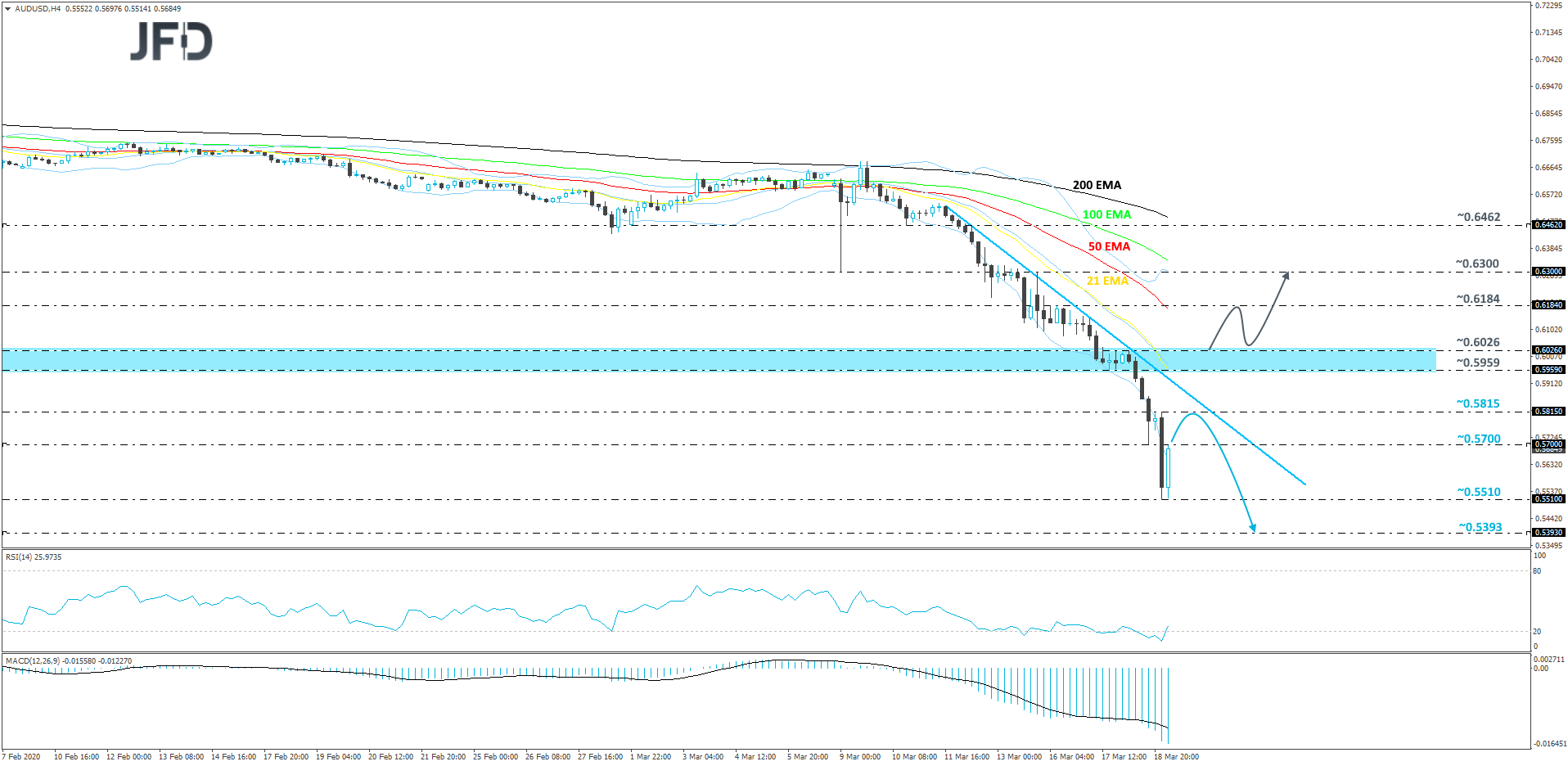
GBP/USD – TECHNICAL OUTLOOK
Given the sharp sell-off which we saw yesterday, GBP/USD fell not only below the lowest point of 2016, at 1.1980, but also below last year’s low, at 1.1958. The pair travelled all the way to the 1.1450 zone, where it found support and rebounded. The rate continues to trade below a short-term tentative downside resistance line taken from the high of March 11th. Even if we could see a bit of correction to the upside, as long as that downside line stays intact, we will remain bearish.
If GBP/USD suddenly makes a move back above this morning’s high, at 1.1661, this may lead to a slightly bigger correction higher. However, if the pair struggles to break the aforementioned downside line, this could attract the sellers back into the game, who could send GBP/USD lower again. We will once again target the 1.1450 area, a break of which would confirm a forthcoming lower low and the next possible support area might be around 1.1240, marked by the highest point of February 1985.
On the other hand, if the rate rushes through that downside line and breaks above the 1.1980 barrier, which is the lowest point of 2016, this could invite a few extra buyers into the arena. Such a move could help GBP/USD to travel back to the 1.2129 obstacle, or even the 1.2273 territory, marked by the high of March 17th. If the buying doesn’t stop there, the next potential resistance area to consider could be around the 1.2421 level, marked by the high of March 16th.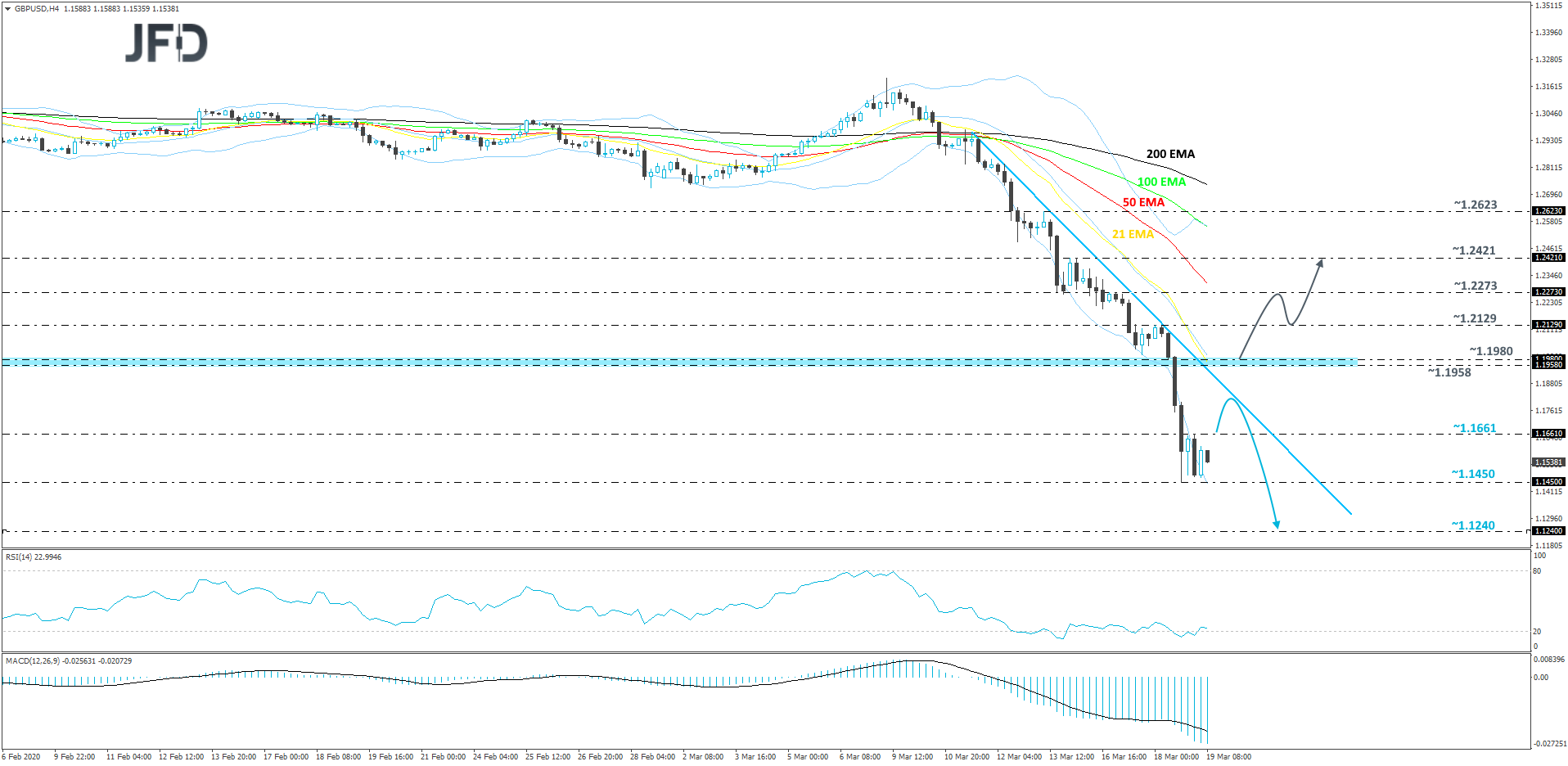
AS FOR THE REST OF TODAY’S EVENTS
During the European session, the central bank torch will be passed to the Norges Bank and the SNB. When they last met, Norwegian policymakers kept interest rates untouched at +1.50% and noted that the policy rate will remain at the present level in the coming period. However, last week inflation data disappointed largely, with the headline rate tumbling to +0.9% yoy from +1.8%, and the core one sliding to +2.1% yoy from +2.9%.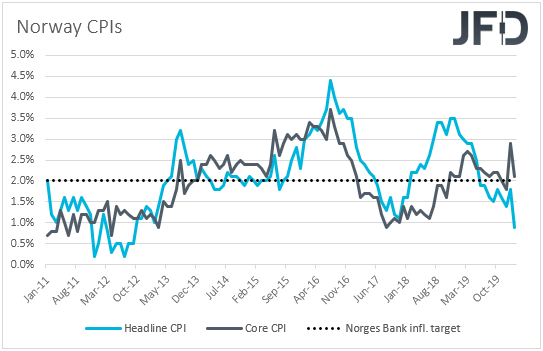
With central banks worldwide easing their respective policies in order to prevent a global recession due to the effects of the coronavirus, a slump in Norwegian inflation may come as an extra reason for policymakers to follow through, especially after the sharp tumble in oil prices.
Passing the ball to the SNB, this may be the only central bank which is unlikely to ease this week. Having the lowest interest rate globally, at -0.75%, the Bank may prefer to fight the virus crisis by intervening in the FX market in order to prevent the franc from keep strengthening, especially with the currency attracting haven flows recently. Another reason we don’t expect the SNB to touch interest rates is because the ECB refrained from doing so. The Bank may just adopt a more dovish language and strengthen its intervention signals.
As for the rest of the day, the only releases worth to mention are the initial jobless claims for last week, which are expected to have risen to 220k from 211k, and the US Philly Fed manufacturing index, which is forecast to have declined to 10.0 from 36.7.
- English (UK)
- English (India)
- English (Canada)
- English (Australia)
- English (South Africa)
- English (Philippines)
- English (Nigeria)
- Deutsch
- Español (España)
- Español (México)
- Français
- Italiano
- Nederlands
- Português (Portugal)
- Polski
- Português (Brasil)
- Русский
- Türkçe
- العربية
- Ελληνικά
- Svenska
- Suomi
- עברית
- 日本語
- 한국어
- 简体中文
- 繁體中文
- Bahasa Indonesia
- Bahasa Melayu
- ไทย
- Tiếng Việt
- हिंदी
As The Market Turmoil Continues, The Greenback Is King
Published 03/19/2020, 04:45 AM
Updated 07/09/2023, 06:31 AM
As The Market Turmoil Continues, The Greenback Is King
Latest comments
Loading next article…
Install Our App
Risk Disclosure: Trading in financial instruments and/or cryptocurrencies involves high risks including the risk of losing some, or all, of your investment amount, and may not be suitable for all investors. Prices of cryptocurrencies are extremely volatile and may be affected by external factors such as financial, regulatory or political events. Trading on margin increases the financial risks.
Before deciding to trade in financial instrument or cryptocurrencies you should be fully informed of the risks and costs associated with trading the financial markets, carefully consider your investment objectives, level of experience, and risk appetite, and seek professional advice where needed.
Fusion Media would like to remind you that the data contained in this website is not necessarily real-time nor accurate. The data and prices on the website are not necessarily provided by any market or exchange, but may be provided by market makers, and so prices may not be accurate and may differ from the actual price at any given market, meaning prices are indicative and not appropriate for trading purposes. Fusion Media and any provider of the data contained in this website will not accept liability for any loss or damage as a result of your trading, or your reliance on the information contained within this website.
It is prohibited to use, store, reproduce, display, modify, transmit or distribute the data contained in this website without the explicit prior written permission of Fusion Media and/or the data provider. All intellectual property rights are reserved by the providers and/or the exchange providing the data contained in this website.
Fusion Media may be compensated by the advertisers that appear on the website, based on your interaction with the advertisements or advertisers.
Before deciding to trade in financial instrument or cryptocurrencies you should be fully informed of the risks and costs associated with trading the financial markets, carefully consider your investment objectives, level of experience, and risk appetite, and seek professional advice where needed.
Fusion Media would like to remind you that the data contained in this website is not necessarily real-time nor accurate. The data and prices on the website are not necessarily provided by any market or exchange, but may be provided by market makers, and so prices may not be accurate and may differ from the actual price at any given market, meaning prices are indicative and not appropriate for trading purposes. Fusion Media and any provider of the data contained in this website will not accept liability for any loss or damage as a result of your trading, or your reliance on the information contained within this website.
It is prohibited to use, store, reproduce, display, modify, transmit or distribute the data contained in this website without the explicit prior written permission of Fusion Media and/or the data provider. All intellectual property rights are reserved by the providers and/or the exchange providing the data contained in this website.
Fusion Media may be compensated by the advertisers that appear on the website, based on your interaction with the advertisements or advertisers.
© 2007-2025 - Fusion Media Limited. All Rights Reserved.
